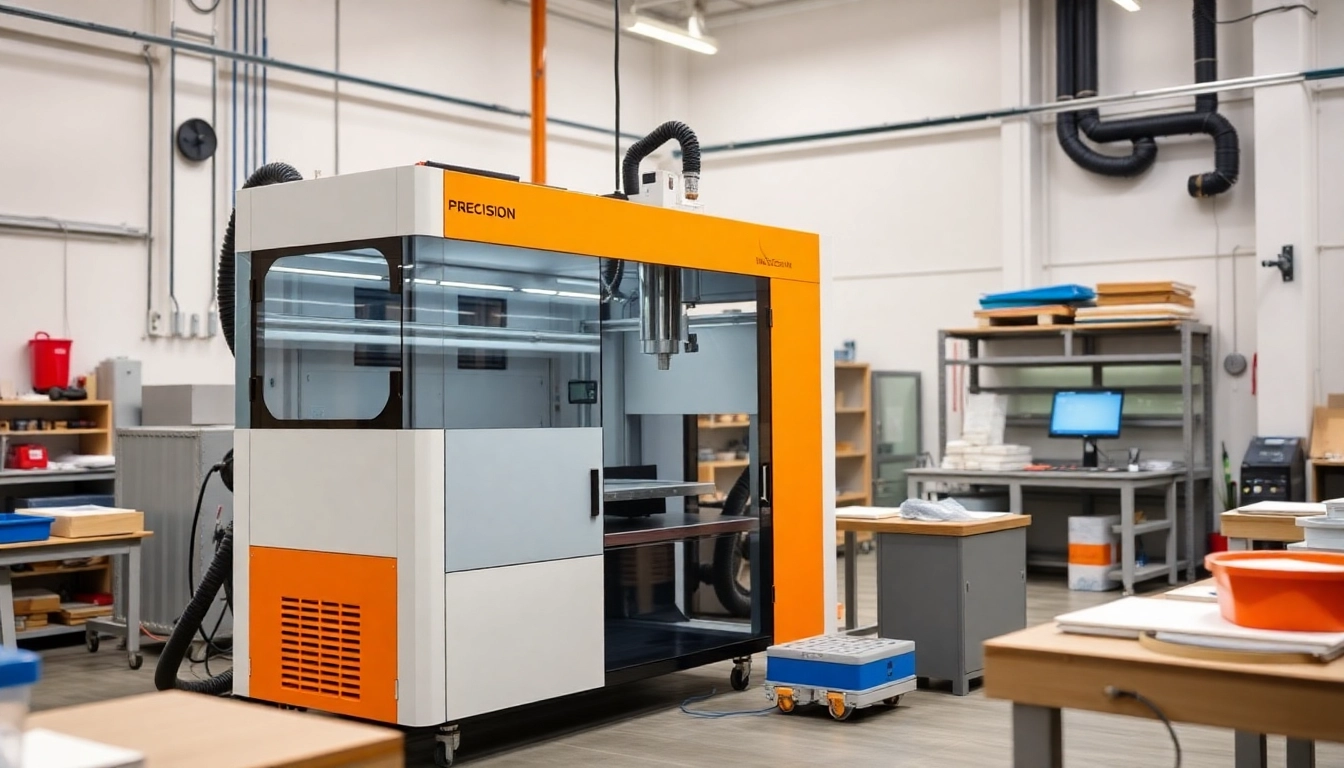Understanding Precision Die Cutting
Precision die cutting is an advanced manufacturing process that converts raw materials such as paper, plastic, and metal into specific shapes using a die. This method is characterized by its accuracy, speed, and capacity to produce large quantities of uniformly cut components. The precision die cutting process is utilized across various industries, from automotive to electronics, where exact specifications are crucial for compatibility and functionality.
What is Precision Die Cutting?
At its core, precision die cutting involves the use of sharp blades or dies to cut material into predefined shapes and sizes. Unlike standard die cutting, which may allow for some variance in dimensions and quality, precision die cutting demands strict adherence to specifications, resulting in higher quality products. The process can employ various techniques, including rotary die cutting, flatbed die cutting, and laser cutting, depending on the application requirements.
Applications of Precision Die Cutting
The versatility of precision die cutting enables its use in numerous applications across multiple sectors:
- Electronics: Used for creating components like circuit boards, insulation layers, and parts that require high precision.
- Automotive: Required for gaskets, seals, and other intricate parts that demand exact specifications.
- Packaging: Essential for the production of custom packaging solutions, providing structural integrity and appealing designs.
- Medical: Employed in producing disposable medical devices and components where safety and precision are paramount.
- Textiles: Utilized to craft patterns, pieces, and other elements in clothing manufacturing.
The Benefits of Precision Die Cutting
Utilizing precision die cutting offers several advantages that can significantly enhance production processes:
- High Accuracy: Tolerances can be as tight as ±0.005 inches, ensuring parts fit together seamlessly.
- Cost-Effectiveness: High-volume production leads to lower unit costs, reducing overall manufacturing expenses.
- Minimized Waste: Precise cuts reduce excess material usage and waste, benefiting both the environment and profitability.
- Versatile Material Compatibility: Capable of handling a variety of materials, including metal, plastic, foam, and fabric.
- Speed: Rapid production methods ensure quick turnaround times, crucial for meeting market demands.
Key Technologies in Precision Die Cutting
Types of Die Cutting Techniques
Numerous die cutting techniques cater to specific needs and projects:
- Rotary Die Cutting: Utilizes a cylinder covered with sharp blades, enabling continuous cutting of materials. Ideal for high-volume projects.
- Flatbed Die Cutting: Involves a flat surface where the material is placed and precise cuts are made. This method is well-suited for short runs and intricate designs.
- Laser Die Cutting: Offers the highest level of precision, utilizing laser technology to cut materials with intricate details and shapes. Perfect for complex designs and prototypes.
Innovative Tools for Precision Die Cutting
Advancements in technology have brought numerous innovations in the tools and machinery used for die cutting:
- CAD Software: Computer-Aided Design (CAD) software is essential for designing precise patterns that can be translated into die cutting.
- Digital Die Cutting Machines: These machines allow for quick adjustments and on-demand production, minimizing setup time and reducing waste.
- Automatic Feed Systems: Enhance production speed by allowing for continuous feeding of material into the die cutting machinery.
Automation in Die Cutting Processes
The integration of automation in die cutting processes streamlines manufacturing operations and improves efficiency:
- Robotic Components: Implementing robotic arms for material handling can drastically reduce manual labor and increase precision.
- Smart Monitoring Systems: These systems ensure consistent quality control by monitoring cuts and materials in real-time.
- Data Analytics: Leveraging data from production processes can lead to enhanced decision-making and optimization of operations.
Choosing the Right Precision Die Cutting Service
Factors to Consider When Selecting a Provider
When seeking a precision die cutting service, several key factors must be evaluated:
- Experience and Expertise: Look for a provider with a strong portfolio and extensive experience in your particular industry.
- Technology and Equipment: Ensure they utilize modern machines and techniques aligned with current industry standards.
- Capacity and Scalability: Assess whether they can handle your current needs and grow with your future requirements.
Questions to Ask Precision Die Cutting Companies
Before making a decision, ask potential providers the following questions:
- What are your tolerances for die cutting, and how do you ensure accuracy?
- Can you provide references or case studies from similar projects?
- What are your lead times for production and delivery?
- What is your process for quality control and assurance?
- How do you handle material mismatches or production errors?
Evaluating Quality and Turnaround Time
Quality and turnaround time are critical to ensuring smooth operations:
- Prototyping: Request prototypes to evaluate the suitability and precision of the die cutting before large production runs.
- Inspecting Quality Standards: Verify compliance with relevant industry standards, such as ISO certifications, to ensure high-quality output.
- Turnaround Times: Discuss and establish realistic timelines to effectively plan your production schedules.
Industry Standards and Tolerances
Understanding Die Cutting Tolerances
Die cutting tolerances play a significant role in the manufacturing process, particularly in industries that demand precision:
- Typical tolerances range from ±0.005 inches for short runs to ±0.15 inches for longer runs.
- Factors influencing tolerances include material type, die design, and the cutting technique employed.
- Evaluate parts closely during the production phase to maintain consistency and quality.
Compliance with Industry Regulations
Compliance with relevant industry standards ensures products are safe and effective:
- Understand the specific regulations that apply to your industry, including environmental, safety, and quality control standards.
- Ensure that your die cutting partner is knowledgeable about these regulations and can assure compliance throughout the production process.
- Seek partners who are transparent about their processes and have proven records of past compliance.
Improving Accuracy in Die Cutting Processes
Enhancing accuracy within die cutting operations can lead to better results:
- Calibration: Regularly calibrate machinery to maintain precision and effectiveness.
- Operator Training: Ensure operators are well-trained in equipment handling and in identifying potential errors.
- Continuous Monitoring: Implement systems for ongoing monitoring during production to detect variances swiftly.
Future Trends in Precision Die Cutting
Emerging Technologies Impacting Die Cutting
The die cutting industry is continually evolving with new technologies:
- Artificial Intelligence: AI can optimize cutting paths and reduce waste while enhancing efficiency.
- 3D Printing Integration: Combining die cutting with 3D printing allows for more complex designs, pushing the boundaries of traditional manufacturing.
- Flexible Manufacturing Systems: Increased flexibility will enable businesses to adapt quickly to changing market demands.
Sustainability and Eco-Friendly Practices
As industries become more environmentally conscious, the demand for sustainable manufacturing practices increases:
- Utilizing recycled materials and eco-friendly substrates in die cutting processes can significantly reduce environmental impact.
- Implementing waste reduction strategies, including optimizing cut layouts to minimize scrap material.
- Investing in energy-efficient machinery aligns with both cost-saving measures and sustainability goals.
Market Predictions for Precision Die Cutting
The precision die cutting market is poised for growth due to various factors:
- Increasing demand for customized solutions across industries is expected to fuel growth in precision die cutting.
- As automation and technology continue to evolve, the cost efficiency of die cutting processes is likely to improve, making it a desirable option for manufacturers.
- Global trends towards sustainability will also shape market dynamics, pushing manufacturers to adopt eco-friendly materials and practices.


